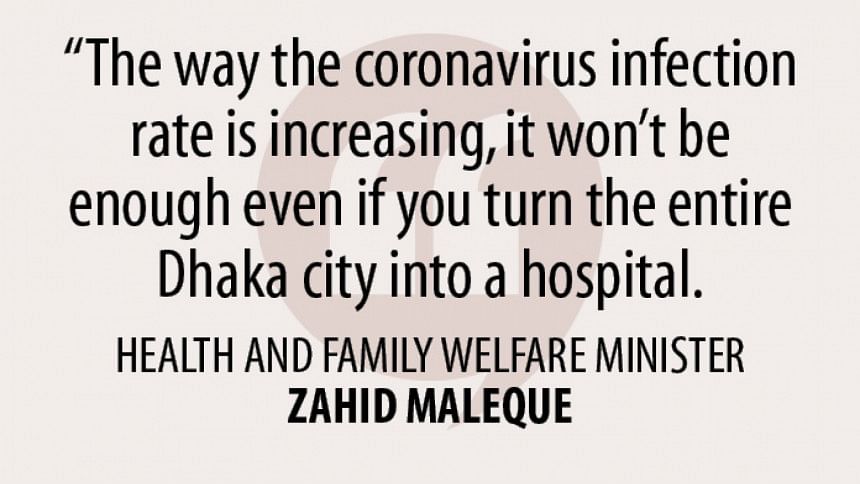Half the country at high risk
The recent spike in Covid-19 infections has turned more than half the country's 64 districts into high-risk zones.
While Dhaka district still accounts for over half the Covid-19 cases in the country, data revealed yesterday by the Institute of Epidemiology, Disease Control and Research (IEDCR) shows that the virus has already spread alarmingly to other parts.
The number of high-risk areas has increased from 10 districts to 38 in just two weeks, according to IEDCR, which defines high-risk zones as those areas with infection rates over 10 percent.

It said 10 districts were defined as high-risk zones between March 2 and 16.
From March 17-30, however, the number of high-risk zones districts jumped to 38, indicating that the virus is fast spreading across the country, the IEDCR data said.
"The Covid-19 virus is spreading like wildfire across the country," Mushtaq Hossain, an adviser to the IEDCR, told The Daily Star yesterday.
He also said the daily positivity rate is on a sharp rise across the country.
The noted epidemiologist said the UK and South African variants may be key factors behind the surge.
"But reckless behaviour of the people and their disregard for healthcare guidelines is the most important reason behind the surge," Mushtaq said.
The country witnessed a second wave of Covid-19 infection and deaths since the second week of March. The daily infection rate, which was between 3 and 3.5 percent in February, crossed the safe 5 percent barrier in early March.
Since then, the infection rate and deaths have continued to surge and in the process the country witnessed one grim milestone after another in terms of infections and deaths.
It forced the government to enforce countrywide restrictions on movement for seven days from April 5 to curb the transmission.
Yesterday, on the second day of the restrictions, the country registered record single-day numbers of 7,213 new Covid-19 cases and 66 more deaths. The daily positivity rate is currently 21.02 percent.

Hospitals are already overburdened with patients. There is an acute crisis of ICU beds and even healthcare professionals are struggling to manage the influx of patients.
To accommodate the growing patients the government has been scaling up the general beds and ICU beds.
Contacted, Health Minister Zahid Maleque said yesterday that the number of general and ICU beds have already been doubled, but people are still struggling to get beds as the number of infections is on the rise.
"The rate of infection and death is on the rise and it will continue for a few days. The virus has already spread across the country. The infection rate will start declining soon, [but] only if we follow healthcare guidelines," he said.
The minister, however, warned against reckless behaviour.

"If the coronavirus rate keeps increasing the way it has been, it would not be possible to treat people even after turning the whole Dhaka city into a hospital," the minister told journalists after visiting a DNCC Covid-19 dedicated hospital.
"How can we manage [increased amounts of] doctors, nurses and provide facilities?"
Maleque said he has already instructed to provide oxygen concentrators to all the upazila health complexes so that those establishments could provide treatment.
Yesterday's new cases took the total Covid-19 cases in the country to 6,51,652 with an overall infection rate of 13.44 percent.
Meanwhile, the death tally reached 9,384 with an overall fatality rate of 1.44 percent.
Among the total deaths, around 58 percent have been recorded in Dhaka, followed by Chattogram with around 19 percent.
MOULVIBAZAR, MUNSHIGANJ AND DHAKA RISKIEST
Among the high-risk districts, those with the highest infection rates are Moulvibazar, Munshiganj and Dhaka where infection rates are 50 percent, 33 percent and 31 percent respectively.
In Moulvibazar, one in every two people tested was found to be positive for Covid-19. Currently, there are 142 positive patients in the district.
Daily positivity rates are between 21 and 30 percent in Sylhet, Khulna, Chattogram, Feni, Narayanganj, Narsingdi, Rajbari and Chandpur districts, according to the IEDCR data.
Chowdhury Jalal Uddin Murshed, civil surgeon of Moulvibazar, told The Daily Star that the main reason for such a high infection rate is that almost all positive cases have a history of coming into close contact with expatriates.
The second reason, he said, is that many have a history of travel within the country and the third reason is that there have been large crowds in Moulvibazar recently as it is a tourism district.

 For all latest news, follow The Daily Star's Google News channel.
For all latest news, follow The Daily Star's Google News channel. 



Comments